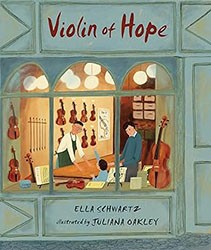For over five years David Kassan has been painting highly realistic, life-size portraits of Holocaust survivors, and a large group portrait of eleven Auschwitz survivors. That polyptych and thirteen individual portraits were exhibited at the USC Fisher Museum of Art from September 18th to December 8th 2019, co-organized by the museum and the USC Shoah Foundation. The exhibition featured not only the portraits, some sketches, and drawings, but also an interactive installation, called “Dimensions in Testimony,” a virtual conversation museumgoers can have with survivors who have been filmed.
Kassan’s project is a marriage of word and image. He begins by meeting survivors and recording their testimony, then sketching and photographing them. He looks at those photographs and reflects on the stories he has been told as he conceives his paintings. In some cases Kassan first listened to the recorded testimony held in the Shoah Foundation archives, but face-to-face interactions with survivors remained integral to his practice. Subtle facial movements, gestures, and body posture, along with objects brought by survivors to the sessions, helped Kassan create what he believes is a more authentic representation of his sitter.
A beautifully produced exhibition catalogue accompanies that show, containing twenty-four of Kassan’s paintings. The expressive and unflinching portraits appear as full-page reproductions on glossy paper, with half-page vertical tip-ins on uncoated paper that contain selected excerpts of the survivor’s testimony. This juxtaposition makes for a very attractive presentation. The high quality of the reproductions allow readers to see how meticulously Kassan paints skin, fabric textures, and other details, all against a muted background. His use of oil on acrylic mirror panel, rather than a more traditional oil on canvas technique, augments the luminosity of the paintings. A dramatic fold-out of the polyptych offers a sense of the scope of his work (the painting is 210-inches by 96-inches), and twelve pages at the end of the catalogue reproduce Kassan’s studies in preparation for the final paintings.
Three of the four short essays and an artist’s statement usefully contextualize the exhibition. The first essay, by executive director of the USC museums Selma Holo, attempts to justify Kassan’s use of realism by degrading avant-garde art. While realism has indeed been in-and-out of favor since the first decades of the twentieth-century that has no bearing on the importance of Kassan’s project. The other essays and Kassan’s artist statement describe his process and the serious intent behind his endeavor; his effort to create portraits that convey his sitters’ Holocaust experience, and also the resilience and richness of their lives after. The theme running through the catalogue’s essays is that of an “art of testimony.” As Kassan put it, “words imbue my work so that each painting becomes the embodiment of witness and passes their testimony onto the viewer.”
Samantha Baskind is Distinguished Professor of Art History at Cleveland State University. She is the author or editor of six books on Jewish American art and culture, which address subjects ranging from fine art to film to comics and graphic novels. She served as editor for U.S. art for the 22-volume revised edition of the Encyclopaedia Judaica and is currently series editor of Dimyonot: Jews and the Cultural Imagination, published by Penn State University Press.





